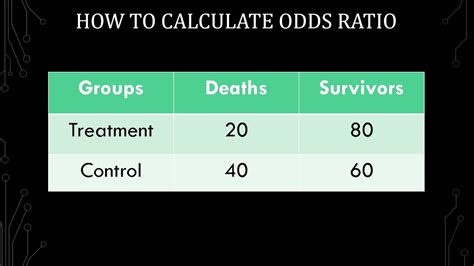how to calculate odds ratio|Explaining Odds Ratios : Clark Odds ratios with groups quantify the strength of the relationship between two conditions. They indicate how likely an outcome is to occur in one context relative to another. The odds ratio formula below shows . Tingnan ang higit pa The transfer of all our lottery prizes to prize winners is not taxable for the prize winner. There may be tax consequences for the prize winner for the ongoing use or sale of the prize. More detailed information can be found via the Australian Taxation Office. Please note RSL Queensland is not able to provide financial or taxation advice.

how to calculate odds ratio,An odds ratio (OR) calculates the relationship between a variable and the likelihood of an event occurring. A common interpretation for odds ratios is identifying risk factorsby assessing the relationship between exposure to a risk factor and a medical outcome. For example, is there an . Tingnan ang higit pa
Before you can calculate and interpret an odds ratio, you must know what the odds of an event represents. In common usage, people . Tingnan ang higit paOdds ratios with groups quantify the strength of the relationship between two conditions. They indicate how likely an outcome is to occur in one context relative to another. The odds ratio formula below shows . Tingnan ang higit pa

The equation below expands the earlier odds ratio formula for calculating an OR with two conditions (A and B). Again, it’s the ratio of . Tingnan ang higit paDue to the odds ratio formula, the value of one becomes critical during interpretation because it indicates both conditions have equal odds. Consequently, analysts always . Tingnan ang higit pa
How to Calculate the Odds Ratio. You have two choices for the formula: (a/c) / (b/d) or, equivalently: (a*d) / (b*c) General Steps: Step 1: Calculate the odds that a member of the population has property “A”. Assume the . Odds Ratio = (odds of the event in the exposed group) / (odds of the event in the non-exposed group) If the data is set up in .If we flip an unbiased coin, the probability of getting heads and the probability of getting tails are equal - both are 50%. Imagine we get a biased coin that makes it two times more likely to get heads. But what does "twice as likely" mean in terms of a probability? It cannot literally mean to double the probability value, because 50% becomes 100%. Rather, it is the odds that are doubling: from 1:1 odds, to 2:1 odds.
Use this tool to easily calculate the odds ratio (OR) between an exposed and control group, as well as the confidence intervals and p-values for the OR. Learn the definition, formula and difference of odds ratio vs. .
how to calculate odds ratio Explaining Odds Ratios Use this tool to easily calculate the odds ratio (OR) between an exposed and control group, as well as the confidence intervals and p-values for the OR. Learn the definition, formula and difference of odds ratio vs. .Enter the number of subjects with positive and negative outcomes in each group to calculate the odds ratio and its confidence interval. The calculator also provides the test of significance and the formula for the .

Learn how to interpret these statistics with a stepwise approach and a concept check question. See examples from a fictional trial of a new cholesterol .Explaining Odds Ratios Learn how to interpret these statistics with a stepwise approach and a concept check question. See examples from a fictional trial of a new cholesterol .
The odds ratio can also be used to determine whether a particular exposure is a risk factor for a particular outcome, and to compare the magnitude of various risk factors for that .
how to calculate odds ratio|Explaining Odds Ratios
PH0 · Odds ratio
PH1 · Odds Ratios—Current Best Practice and Use
PH2 · Odds Ratio: What Does It Tell You?
PH3 · Odds Ratio: Formula, Calculating & Interpreting
PH4 · Odds Ratio Calculator
PH5 · Odds Ratio Calculation and Interpretation
PH6 · Odds Ratio
PH7 · MedCalc's Odds ratio calculator
PH8 · Explaining Odds Ratios
PH9 · A beginner's guide to interpreting odds ratios, confidence intervals